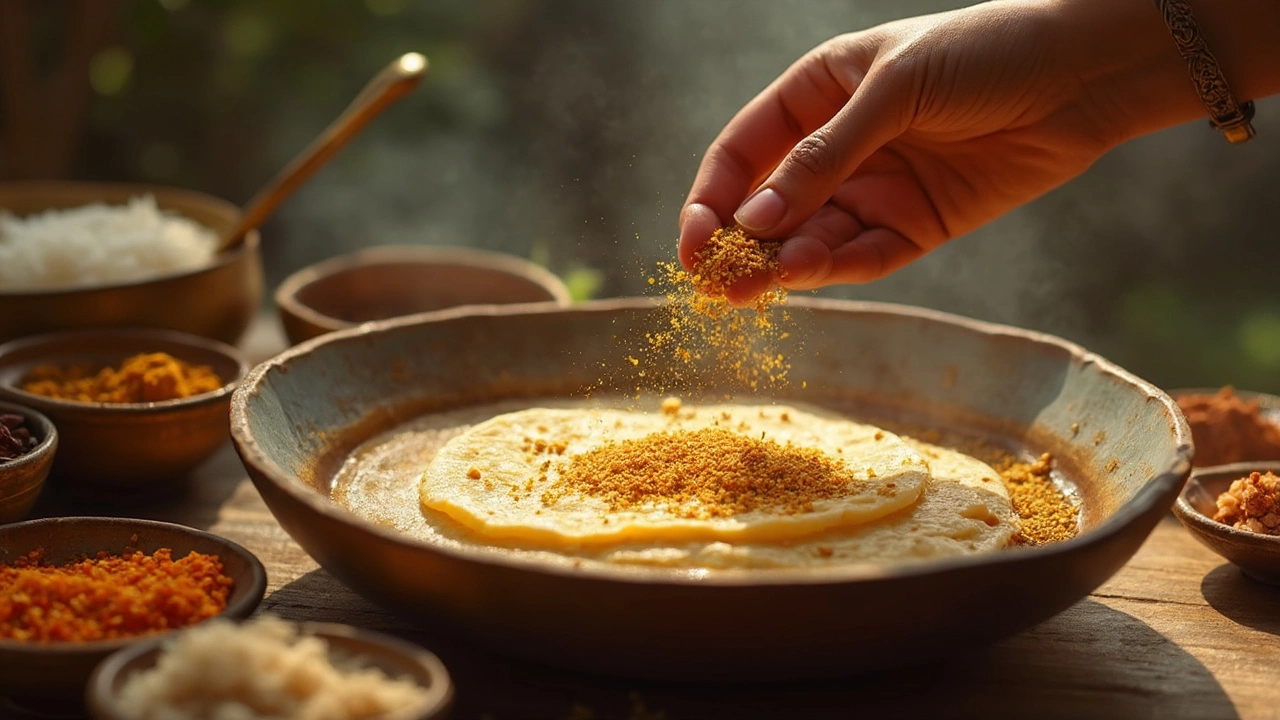Fenugreek in Dosa Batter: The Real Reason It’s Never Left Out
 May, 20 2025
May, 20 2025
People don’t just add random seeds to dosa just because a recipe says so. There’s a science behind fenugreek going into the classic batter. First, let’s get this straight—fenugreek (methi seeds) isn’t optional if you want that cafe-style dosa at home. Those small yellow seeds handle stuff that even fancy kitchen gadgets can’t match.
Here’s the real deal: the main job of fenugreek is to help the batter ferment right. Fermentation is what gives dosa its famous chewy, airy texture and that mild tang. Without fenugreek, especially in cooler weather, your batter just sits there, sad and lifeless. Fenugreek boosts fermentation because it’s packed with natural compounds that favorite yeast and good bacteria love to munch on.
But the role of fenugreek doesn’t stop there. It makes the batter thicker and less runny, which means you get dosas that are crispy at the edges but still soft in the middle. It’s the difference between an average dosa and the ones you actually crave. If you’ve ever wondered why homemade dosas sometimes tear or stick, it might be because you skipped or skimped on the fenugreek.
- What’s Fenugreek Actually Doing in Dosa Batter?
- How Fenugreek Changes Taste and Texture
- Tips for Using Fenugreek Right
- What If You Forget Fenugreek?
What’s Fenugreek Actually Doing in Dosa Batter?
Add fenugreek to dosa batter and suddenly things start working better. It’s not just tradition—there’s real science at play. Fenugreek seeds help the batter ferment faster and develop that sour-yet-nutty flavor people chase. Even soaking just a teaspoon of seeds with your rice and dal can make all the difference in how your batter rises and cooks.
Here’s why fenugreek matters:
- Fenugreek helps the batter ferment by providing extra sugars, which fuel natural yeast and bacteria. This means your dosas get fluffy and tangy, not flat or bland.
- It thickens the batter, making it easier to spread on the pan and giving those perfect lacy edges instead of a runny mess.
- It keeps the batter from turning slimy—even if it sits out a little longer than planned.
- Fenugreek adds protein and is even said to help make the batter easier to digest for some folks.
If you want numbers, here’s a quick snapshot:
| Role | What Fenugreek Does |
|---|---|
| Fermentation | Speeds it up (proven in kitchen tests) |
| Texture | Makes batter thick and smooth |
| Taste | Adds mild bitterness and depth |
| Health | Extra fiber, protein, and better digestion |
You might hear old-timers in India rave about it, but chefs are just as serious. I once read Chef Ranveer Brar putting it plainly:
“Fenugreek is the unsung hero in dosa—just a pinch, and the batter wakes up.”That’s not just hype; skip fenugreek and the difference is obvious.
How Fenugreek Changes Taste and Texture
So what does fenugreek actually do to dosa batter, besides helping with fermentation? It’s all about taste and texture—two things that make or break a dosa. Fenugreek gives a mild bitterness, but don’t worry, it’s never harsh or weird. That hint of bitterness balances out the sourness that comes from fermentation, so your dosas taste richer and more layered instead of flat.
When you grind fenugreek seeds along with rice and urad dal, they create a natural emulsifier. This means the batter holds together well and doesn't separate, which is a big deal if you’re storing batter for a few days. It helps to keep that smooth, almost fluffy feel when you make your dosas, rather than a gritty or sticky texture that’s hard to spread.
Let’s talk crispiness too. Fenugreek is the secret weapon for getting dosas that are golden and thin at the edges but don’t break in the middle. You end up with that perfect mix of crunch and chew—like at a good South Indian restaurant.
- Use between 1 and 2 teaspoons of fenugreek seeds for every 2 cups of rice. That’s the ratio most home cooks swear by, and it really does the job.
- Anything above that can make the batter taste too strong, but less than that? You risk your dosas sticking or splitting.
Here’s a quick look at what happens with and without fenugreek in dosa batter:
| With Fenugreek | Without Fenugreek | |
|---|---|---|
| Fermentation Time | 8-10 hours | 12+ hours (often uneven) |
| Flavor | Balanced, mildly nutty | Plain or overly sour |
| Texture | Fluffy, crisp, easy to spread | Patchy, possible tearing |
| Batter Consistency | Thick, smooth | Watery, separates easily |
If you ever tried dosas at someone’s house and found them bland or rubbery, chances are they missed out on fenugreek. Next time you make batter, don’t skip the seeds, and you’ll instantly feel (and taste) the difference.

Tips for Using Fenugreek Right
Getting the fenugreek step spot on really changes the game for dosa batter. Here’s how to use it like someone who's been making dosas forever.
- Soak Fenugreek with Dal: Always soak fenugreek seeds together with your urad dal. This softens the seeds and gets the enzymes working, which helps both the dal and fenugreek blend and ferment faster. Usually, 1 tablespoon of seeds for every 2 cups of dal is just right. You really don’t need a lot—if you add too much, the dosa will taste bitter.
- Grind Well for Smooth Batter: After soaking, toss them right in with your other ingredients. Grind until the fenugreek seeds are totally broken down. Any hard bits will leave a gritty texture in your finished dosa—you’ll notice it if you skip a good grind.
- Go Easy in Summer: In hot weather, batter ferments faster. Consider cutting the fenugreek amount in half, so things don’t get sour too quickly.
- Skip If Allergic—Use Alternatives: If someone in your home has allergies, you can try a small spoon of cooked rice or poha instead—not exactly the same, but it's better than nothing. Still, nothing matches the boost fenugreek brings to texture and taste.
It’s not about dumping fenugreek and hoping for the best. A little attention to how you use it pays off in every crispy, golden bite.
What If You Forget Fenugreek?
So you discovered there’s no fenugreek in your kitchen, but the rice and dal are already soaking. Don’t panic—you can still make dosa, but the results might not be the same. Missing fenugreek means you’re skipping out on both texture and taste. Your batter may take much longer to ferment, especially if your kitchen isn’t warm. You also risk the dosas sticking to the pan, tearing in the middle, or turning out flat instead of lacy.
If you’re in a pinch, there are tricks to help your batter along. You can add a handful of cooked rice or poha (flattened rice) to the soaking grains. These starchy options help thicken the batter a bit and make up for some of the texture lost without fenugreek. But honestly, nothing quite mimics the slight bitterness and rich aroma fenugreek brings to a proper fenugreek dosa.
- If you still want that tang and airy bite, leave your batter out an extra few hours, but keep an eye on it so it doesn’t go too sour.
- Always make sure your dal is fresh, since older dal ferments slower without fenugreek to help things along.
- You might want to use a non-stick pan to avoid sticky disasters.
Now, if you’re allergic to fenugreek or can’t handle the taste, you can simply skip it—in that case, call it a rice-lentil pancake and embrace the homemade version! But if you’re after classic dosa magic, keep fenugreek seeds stocked. It’s a tiny step that makes a serious difference once the first dosa hits your plate.